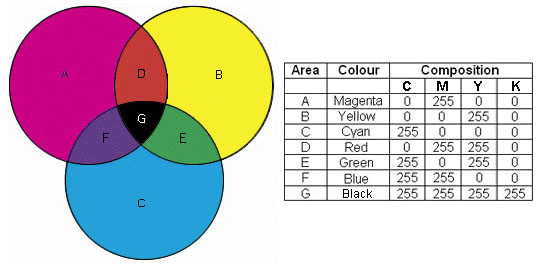
The CMYK model is known as a subtractive model because it progressively removes colours from white light, and is hence the inverse of the RGB model. A sheet of white paper is changed in colour by applying, for example, cyan ink which absorbs red light. Only the blue and green cones in the eye therefore react to light reflected from the cyan area. Magenta ink absorbs green light, so only the red and blue cones in the eye react to light reflected form it. The black element, K, is required to achieve true black because of the limitations of pigments used in printing inks result in not quite all light being absorbed by the three primary colour inks.
An eight-bit, 256-step scale for each of the primary colours allows about 16.7 million different colours to be produced (256 x 256 x 256). Each of the three primary colours is allocated a value in the range 0 - 255 for each pixel, giving 24-bit colour. True red has a cyan value of 0, a magenta value of 255 and a yellow value of 0. Green has a cyan value of 255, a magenta value of 0 and a yellow value of 255. True blue has a cyan value of 255, a magenta value of 255, and a yellow value of 0. Black results, theoretically, from no light being reflected by areas covered in all three primary inks.